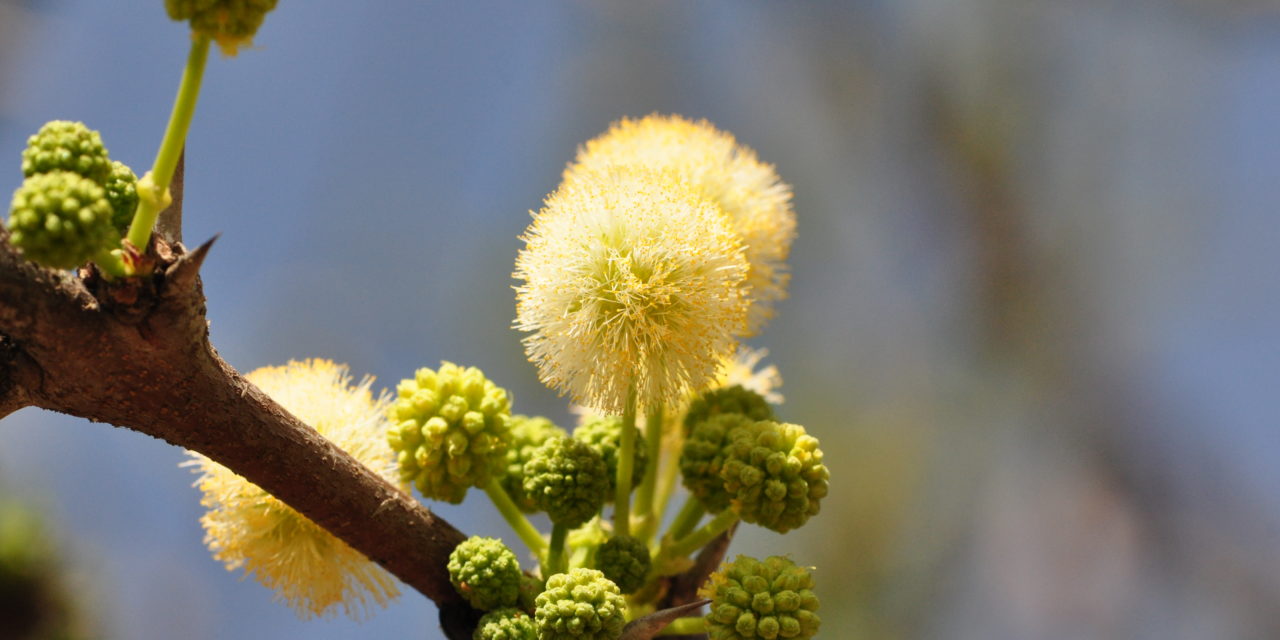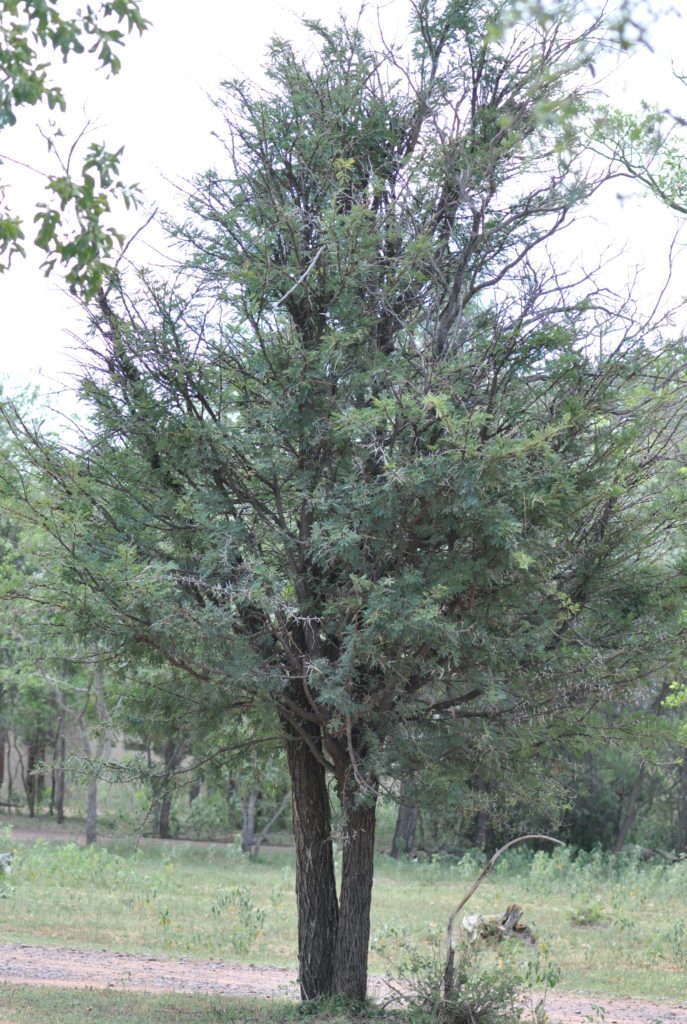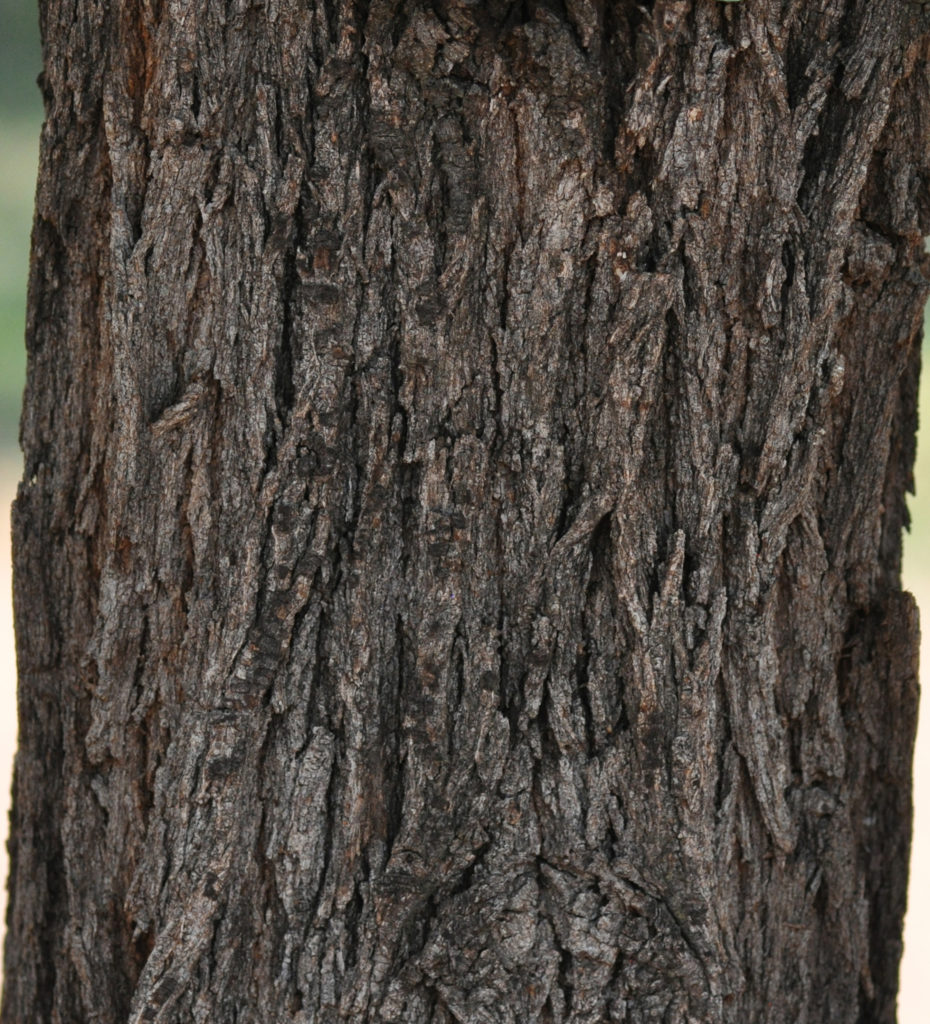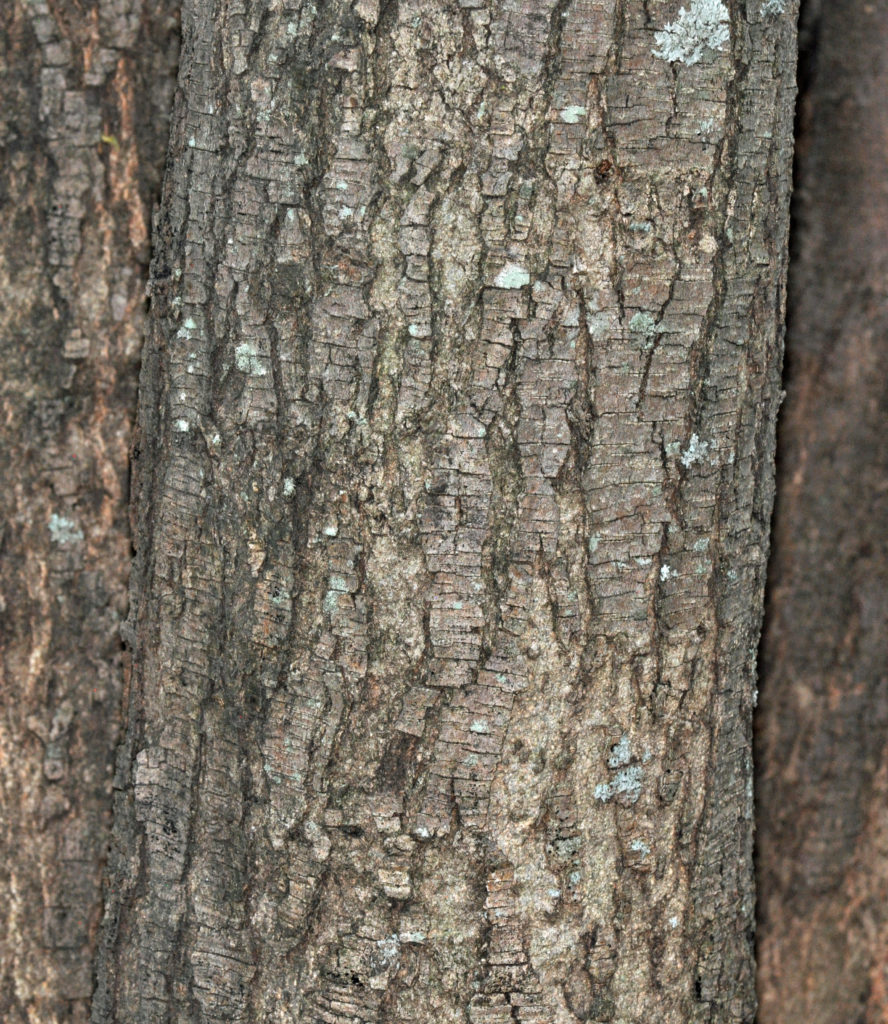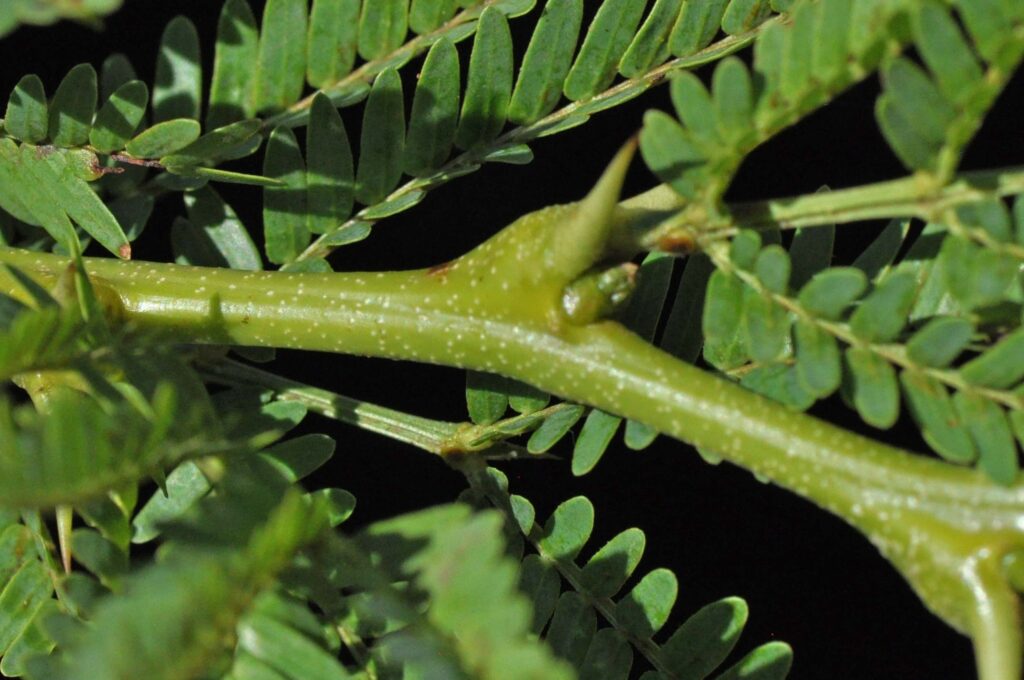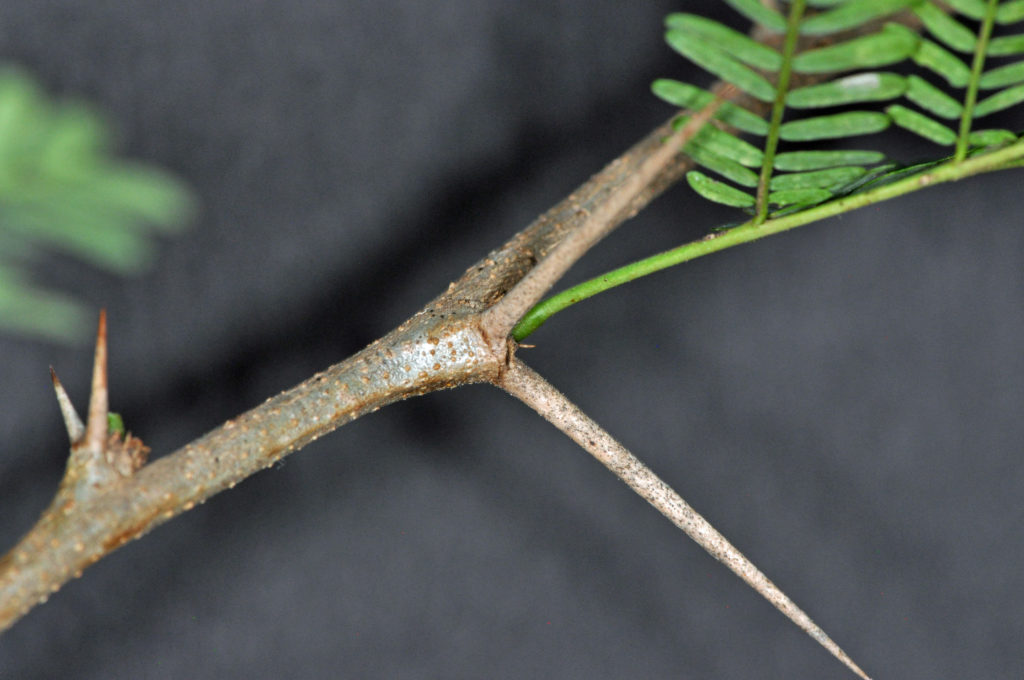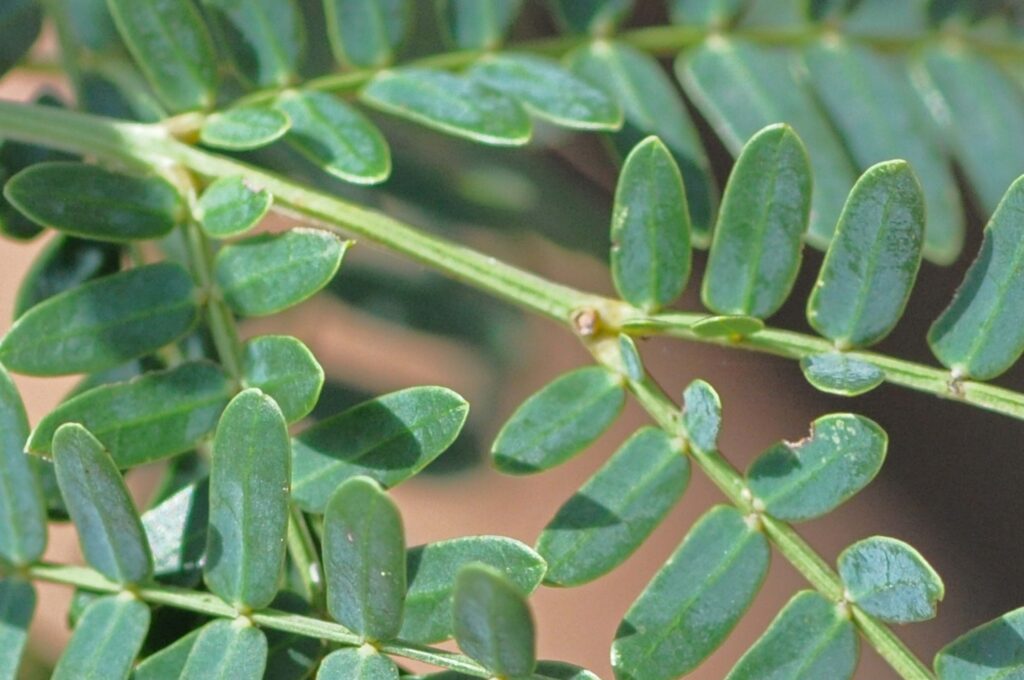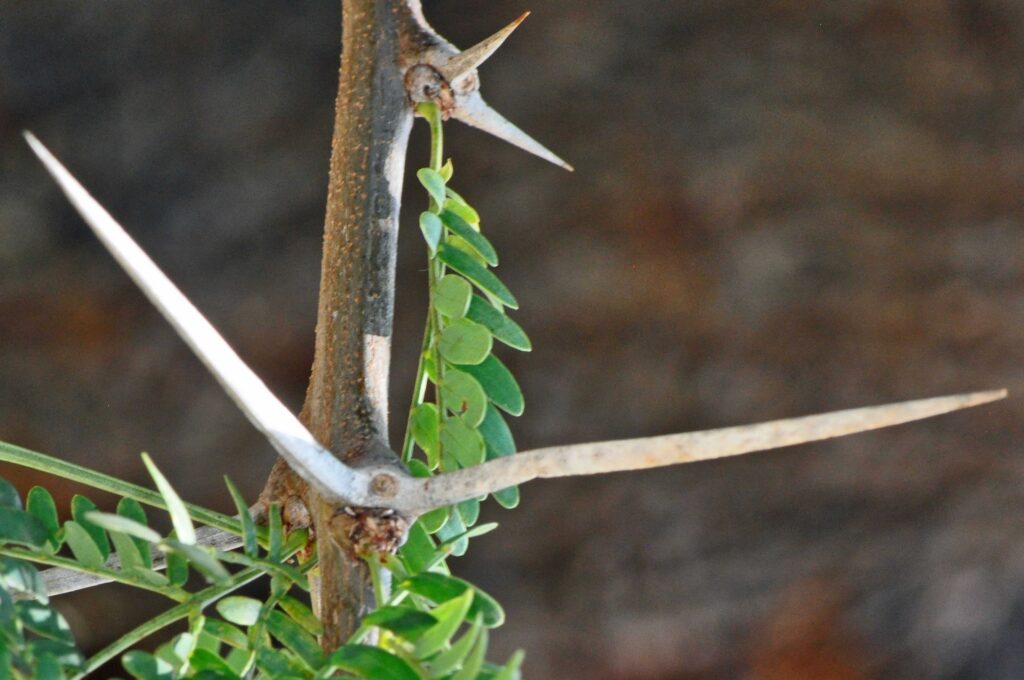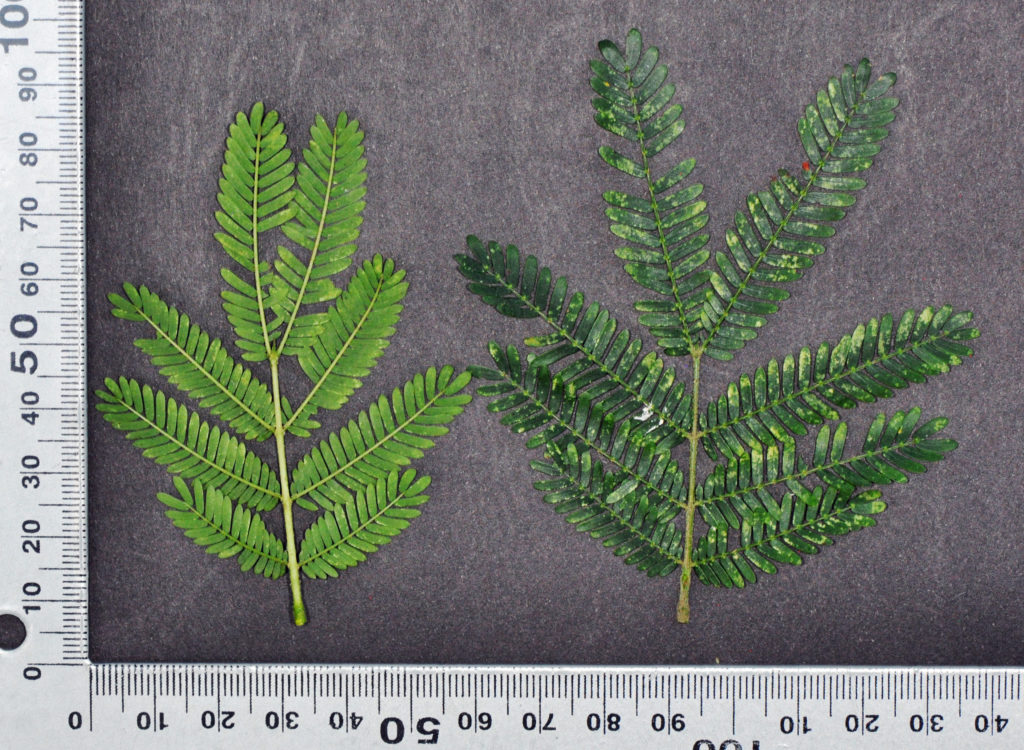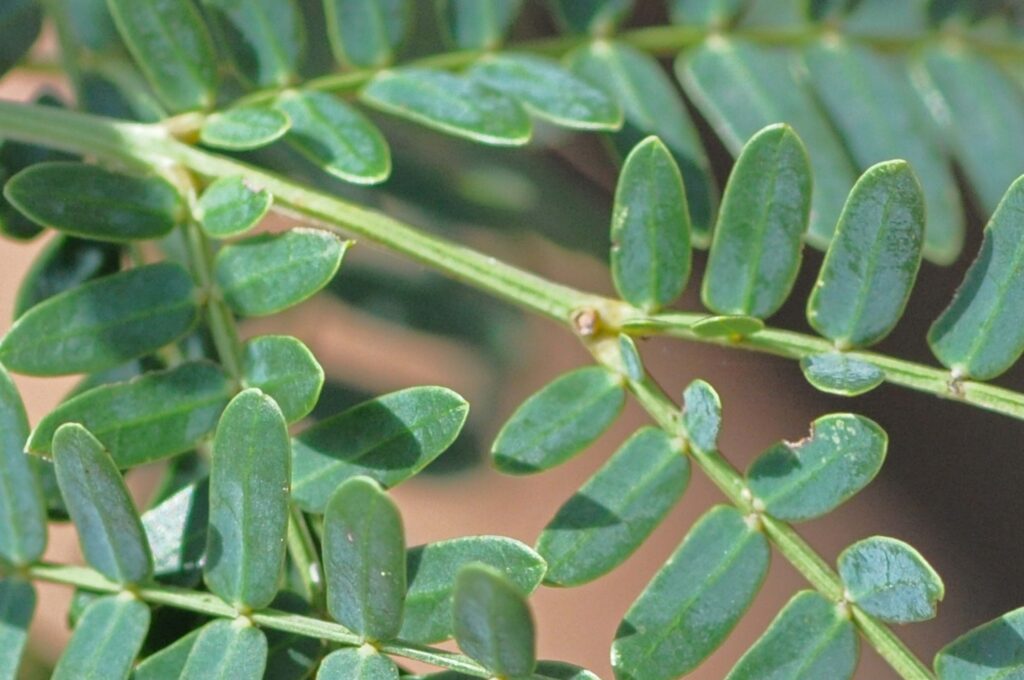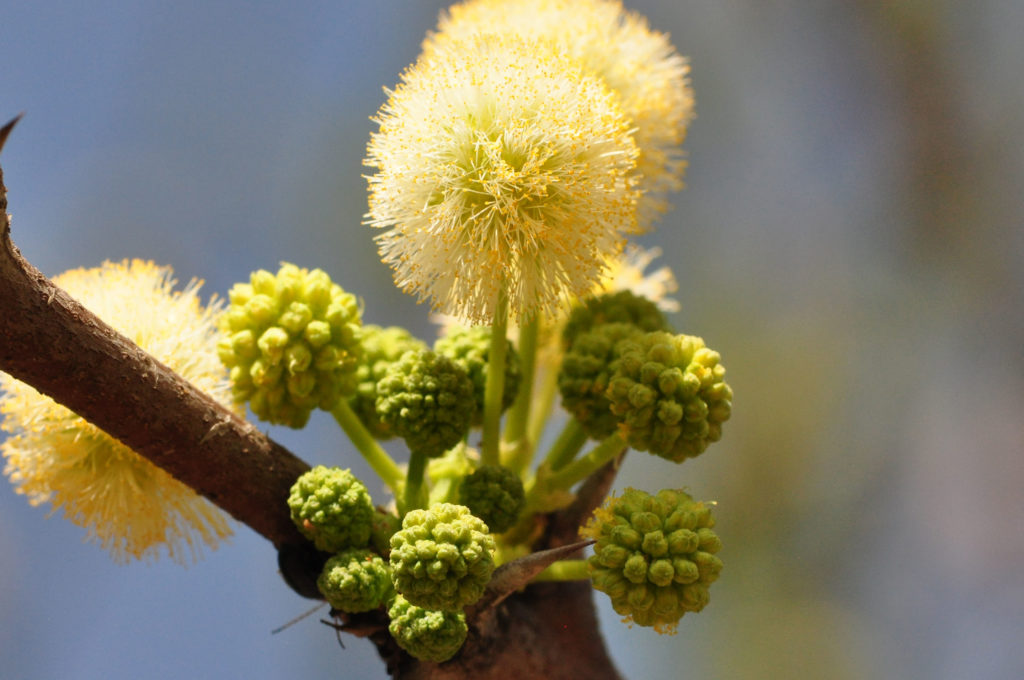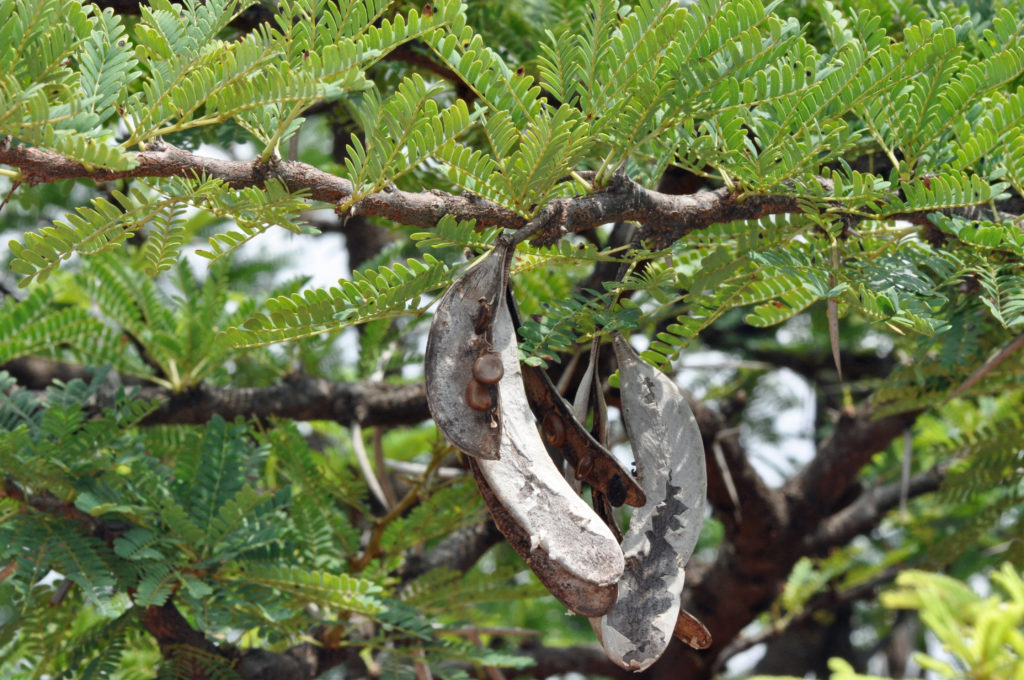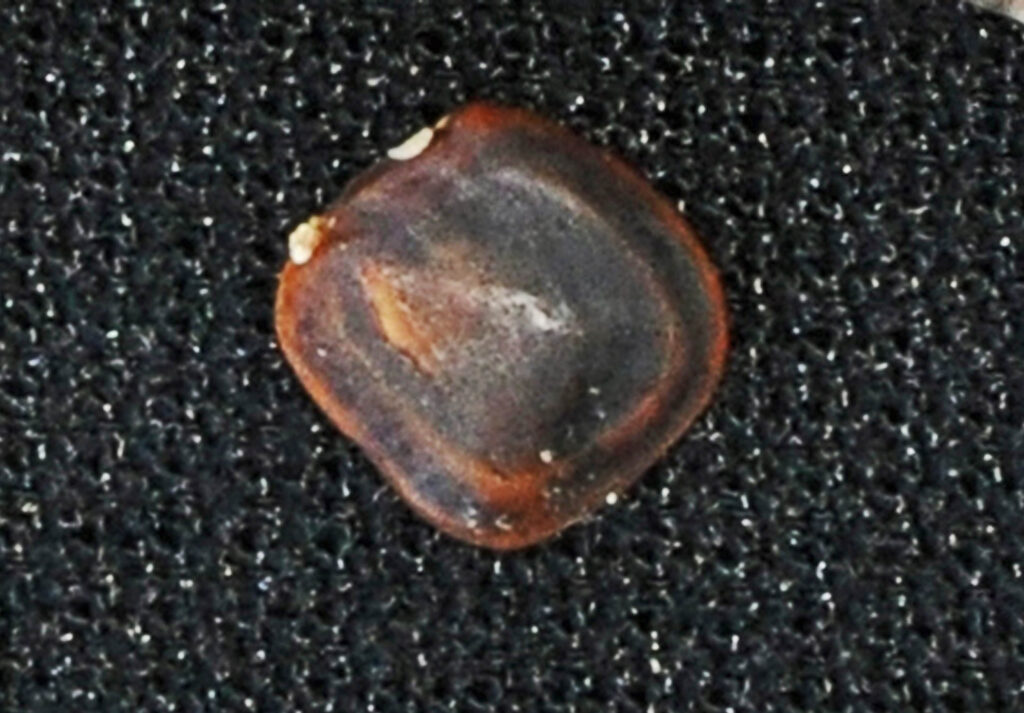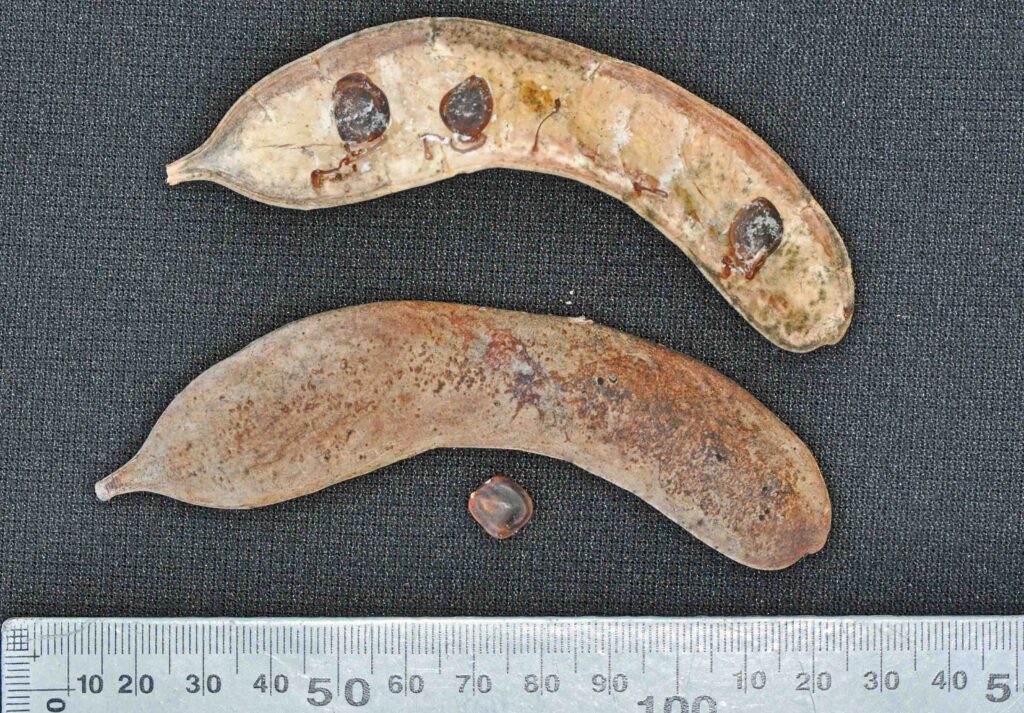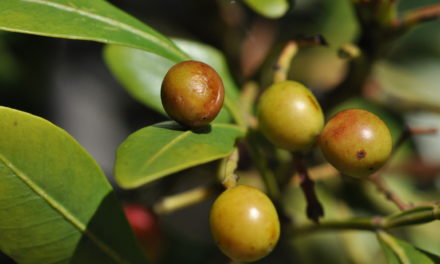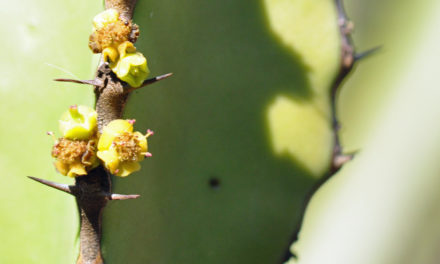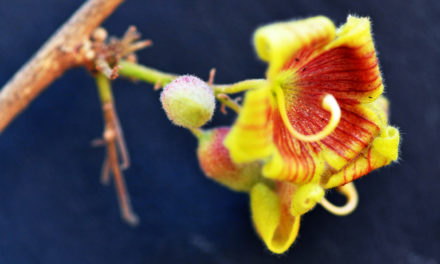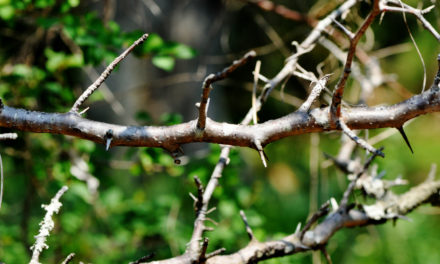General Info – summary
The impressive Tree with upright branches is usually single stemmed and up to 20m high. The grey/black mature bark is deeply fissured. Bipinnate Leaves + spaced leaflets + whitish spinescent stipules. Regular bisexual 5-merous Flowers are in capitate spikes. Exserted stamens generate flower colour and surround the pistil with its superior ovary and extending style. Fruit is a wide, straightish pod with shiny seeds.
Description
Vachellia robusta. subsp. robusta.
Previous Names: Acacia robusta subsp. robusta, Acacia clavigera, Acacia sambesiaca.
SA Tree No. 183.
Common names: (Afr) Aapkop, Bergkameel, Bergkameeldoring, Brakdoring, Brosdoring, Engelse Doring, Engelsedoring, Enkeldoring, Kameeldoring, Oudoring, Praaldoring, Pragdoring, Pronkdoring, Vals-haak-en-steek. (Eng) Ankle Thorn, Brack Thorn, Brag Thorn, Broad-pod Robust Thorn, False Umbrella Thorn, River Thorn, Robust Thorn, Splendid Acacia, Splendid Thorn. (isiXhosa) Umngampunzi. (isiZulu) Umngamanzi, Umngampunzi, Umnquawe. (Northern Sotho) Moku, Mooka. (Setswana) Moga, Mokhu, Moku. (Tshivenda) Muvumba Ngwena. (isiXhosa) Umngampunzi. (isiZulu) Umngamanzi, Umngampunzi, Umnquawe. (Xitsonga) Munga, Mungamazi, Mvumbangwenya.
Family: Fabaceae, or Leguminosae (Pea, bean or legume family). After the Orchidaceae and the Asteraceae, the Fabaceae is the third largest Angiosperm (flowering plants) family with 700+ genera and close to 20 000 species. Local Tree genera on this website include Acacia (Vauchellia, Senegalia), Albizia, Bauhinia, Bolusanthus, Burkea, Calpurnia, Colophospermum, Cordyla, Cyclopia, Dichrostachys, Erythrina, Erythrophleum, Faidherbia, Indigofera, Mundulea, Peltophorum, Philenoptera, Piliostigma, Schotia and Xanthocercis. The Fabaceae are recognisable by their fruit and by their pinnately compound Leaves. Leaves may also be simple – even bilobed and usually have stipules – some of which may be spinescent. Leaflets are usually entire. Flowers are bisexual and bracteate. Regular flowers usually have 4-5 sepals and the same number of petals. Irregular flowers have 4-5 sepals and 5 or less petals. Stamens have anthers that have 2 pollen sacs and there are usually at least twice the number of stamens as petals – often 10. The superior Ovary has one locule that may contain 1 or more ovules. The Stigma and Style are simple. The single carpel develops into the Fruit, which is usually a pod. This pod dehisces on both sides and may break into segments. Seeds vary.
Name derivation. Species of the genus Vachellia and Senegalia were considered members of the genus Acacia until 2005. New Names. The genus Vachellia was named after George H. Vachell (1789 – 1839), chaplain and plant collector in China. Here the inflorescence is capitate (head like) and spinescent stipules are present. Plants in the genus Senegalia – (from Senegal) usually do not have spinescent stipules and the inflorescence is usually a spike. robusta – robust – referring to the appearance of tree.
Conservation: National Status: L C. (Least Concern). Assessment: 2020 (L. von Staden).
Tree
This usually single stemmed Tree branches almost vertically (photo 357). It is usually up to 10m high but may reach 20m. This medium to large tree is usually taller than wide and has a slightly flattened, rounded or irregular spreading Crown (photo 357). The young branch ends are quite thin, appear to droop and may be hairy. Lenticels (a usually raised corky oval or elongated area on the plant that allows the uncontrolled interchange of gases with the environment) are clearly visible on the younger branches (photos 33 & 30). Stems and branches are noticeably thick. Nodes (points on a stem where the buds, leaves, and branching twigs originate) are swollen. The space between 2 nodes is the internode (photos 33 & 30). The Bark may vary between grey, dark brown and black. The initially smooth bark may become deeply fissured and rough with age (photos 354 and 27).
- 357. 2014/02/18. Marakele NP. Photo: David Becking.
- 354. 2014/02/18. Marakele NP. Photo: David Becking.
- 27. 2015/01/27. Walter Sisulu NBG. Photo: David Becking.
- 33. 2016/10/25. Pretoria NBG. Photo: David Becking.
- 30. 2015/01/27. Walter Sisulu NBG. Photo: David Becking.
Leaves
This deciduous tree has Leaves that are grouped on woody cushions above the spines (photo 30 – above) and tightly clustered around the branches. Leaves are bipinnate (Compound: twice pinnate. The central axis – Rachis (main axis bearing flowers or leaflets) has pinna (lateral “branches”) not leaflets and the leaflets (pinnules) are on these pinnae. Leaves together with the Petiole (leaf stalk) are up to 10cm long. Each leaf has 2-7 pairs of Pinnae (photo 28). Each pinna is up to 8cm long and has 10-27 pairs of Leaflets (pinnules) that have distinct spaces between them (photo 355E). Leaflets are glossy dark green above, lighter below and each is up to 1,3 x 0,5mm (photo 28). The petiole is up to 2cm long and Rachis are hairless, or nearly so, up to 6,5cm long and grooved along the top (photo 33 upper right – under Tree). In subsp. claivigera the rachis is hairy. The petiole is usually up to 2cm long. Glands are usually present on the rachis between the top pair of pinnae (photo 355E) and may appear on the petiole (photo 28). The Stipules (basal appendages of the leaf petiole) are spinescent (photo 706E). These stout paired Spines are white or greyish. They may be straight or slightly curved and are visible with the leaves and flowers. Each spine is up to 12cm long (photo 706E) on new growth but may be as small as 2cm or even absent.
- 355E. 2014/02/18. Marakele NP. Photo: David Becking.
- 706E. 2014/10/30. Pretoria NBG. Photo: David Becking.
- 28. 2015/01/27. Walter Sisulu NBG. Photo: David Becking.
- 355R. 2014/02/18. Marakele NP. Photo: David Becking.
Flowers
The impressive, pleasantly scented white to creamy white or yellowish Flowers (photo 383) often appear before the leaves in early spring. They develop in much reduced capitate (formed like a head) Spikes (simple indeterminate inflorescence with very thin sessile flowers on a single unbranched axis opening in succession towards the apex). Many spikes occur with new leaves or on bare branches (photo 383). Each spike, with its ball of flowers is up to 1,8cm in diameter and supported by a Peduncle (stalk of flower cluster photo 383). Individual flowers are very small, usually bisexual and actinomorphic (Regular, symmetrical. Flowers are vertically divisible into similar halves by more than one plane passing through the axis). The Calyx is up to 3,2mm long and the Corolla is up to 4mm long. Flower colour is due to the mass of free exserted (sticking out) Stamens. They surround the single Pistils (units of the Gynoecium, the female element of the flower, composed of the Ovary, Style and Stigma). Each pistil contains a single superior Ovary, with a single, thin Style that ends with a small, single and concave Stigma. After the stamens have shed their pollen, the style elongates and extends the stigma beyond the anthers and here the stigma becomes receptive to pollen. This delayed development helps prevent self-pollination. (Jun-Sep).
- 383. 2017/08/03. Pretoria NBG. Photo: David Becking.
Fruit
The straight or slightly curved and dehiscent Fruit is a rather woody, broad Pod that may reach 18 x 2cm. It is flattish, grey to dark brown to reddish-brown or blackish. The glabrous (hairless) pod is not constricted between the seeds (photo 46). Most of these pods are dehiscent but some remain on the trees with their seeds still attached (photo 391). Up to 14 straight, shiny Seeds (photo 46) develop in each pod. In this photo the small funiculus (the stalk by which the ovule/seed is attached to the ovary wall or placenta) is visible. In photo 46E, of a single seed, a horse-shoe-shaped marking is visible on the almost rectangular and swollen seed. (Oct-Jun). In Vachellia karroo, the pods are narrow and usually much more curved. (Nov-Jun).
- 391 2016.11.08 Pretoria NBG. Photo: David Becking.
- 46E. 2016/10/25. Pretoria NBG. Photo: David Becking.
- 46. 2016/10/25. Pretoria NBG. Photo: David Becking.
Distribution & Ecology
Rhizobium is a genus of gram-negative bacteria, which develop in the root nodules. They are responsible for fixing atmospheric nitrogen and converting it to ammonia and organic nitrogen compounds like glutamine for the plants (a natural fertilizer). In this Symbiotic relationship, the bacteria use organic compounds supplied by the plant for their own benefit. In contrast to this, brown or black seed beetles in the family Chrysomelidae, live most of their lives within a single seed and destroy it. Insects are attracted to the flowers. Birds hunt insects including beetles and consume the seeds. Insects on or under the bark are consumed by the Dark-backed weaver (Ploceus bicolor). The trees are reasonably frost tolerant and are usually found away from the coast. They may extend up rivers in drier areas, bushveld, in savanna (is a rolling grassland scattered with shrubs and isolated trees, which can be found between a tropical rainforest and desert biome) and wooded grassland. Trees grow in the Northern Cape – rare, Free State – rare, Eastern Cape – rare, northwards through KwaZulu-Natal, Gauteng e.g., Melville Koppies, Limpopo, North-West Province, Mpumalanga, Swaziland, Mozambique – here both subspecies are fairly widespread, Namibia, Botswana, Zimbabwe and Malawi. These plants are hardy, cold and drought resistant and usually occur below 1 500m. Rhino consume the Bark and Pods. Herbivorous animals browse the Leaves. Monkeys eat the leaves, roots and stems. The bark exudes Gum (a water-soluble sugary polysaccharide) that monkeys and baboons consume. Huge larvae of the brown longhorn Beetle (Macrotoma palmata) – family Cerambycidae may occur in Vachellia trees – including Vachellia robusta. These edible cerambycid larvae are a good source of fat and are consumed by local people. However, these insects attack woody areas and may eventually destroy host trees.
Ethnobotany
The presence of this fast-growing plant is an indication of sourveld (veld that is largely covered with coarse seasonal perennial grasses and affords inferior grazing). Leaves are reported to be slightly toxic to stock but some animals like the kudu do graze the leaves and Pods. These pods have a crude protein value of 12%. The Wood is outwardly hard and light coloured. The heartwood is dark and has a moderately coarse texture. The whitish sapwood is subject to borer attack that may be reduced by water seasoning. A Fungus may also discolour the wood. Cut wood tends to warp. It is not a good timber or fuel source. The Bark is used to for tanning and inner bark is used to make twine. Scarifying the Seeds will help their otherwise poor ability to germinate. It grows relatively quickly but should be kept away from buildings because of its aggressive Roots. The roots may be poisonous. This plant can develop into a good shade tree. In Australia, this Tree is considered invasive.
References
Boon, R. 2010. Pooley’s Trees of eastern South Africa. Flora and Fauna Publications Trust, Durban.
Burrows, J.E., Burrows, S.M., Lotter, M.C. & Schmidt, E. 2018. Trees and Shrubs Mozambique. Publishing Print Matters (Pty) Ltd. Noordhoek, Cape Town.
Coates Palgrave, M. 2002. Keith Coates Palgrave Trees of Southern Africa, edn 3. Struik, Cape Town.
Foden, W. & Potter, L. 2005. Vachellia robusta (Burch.) Kyal. & Boatwr. subsp. clavigera (E.Mey.) & Kyal. & Boatwr. National Assessment: Red List of South African Plants version 2020.1. Accessed on 2020/11/13.
Ginn, P. J, McIlleron, W.G, & Mimstein, P. le S. 1991. The Complete Book of South African Birds. Struik, Cape Town/Singapore.
Palmer, E. & Pitman, N. 1972. Trees of southern Africa. Balkema, Amsterdam, Cape Town.
Ross, J. H. A conspectus of the African Acacia Species. 1979. Botanical Research Institute.
Lawrence, G. H. M, 1951. Taxonomy of Vascular Plants. The Macmillan Company, New York. Tenth Printing 1965.
Schmidt, S. Lotter, M. & McCleland, W. 2002. Trees and Shrubs of Mpumalanga and the Kruger National Park. Jacana, Johannesburg.
van Wyk, B. & van Wyk, P. 1997 Field guide to Trees of Southern Africa. Struik, Cape Town.
von Staden, L. 2020. Vachellia robusta (Burch.) Kyal. & Boatwr. subsp. robusta. National Assessment: Red List of South African Plants version. Accessed on 2024/03/10.
http://witkoppenwildflower.co.za/acacia-robusta-robusta/
http://pza.sanbi.org/vachellia-robusta-subsp-robusta
http://operationwildflower.org.za/index.php/albums/genera/acacias/acacia-robusta-jw-1525
http://waynesword.palomar.edu/plaug99.htm
http://posa.sanbi.org/flora/browse.php?src=SP
https://www Merriam-Webster.com/dictionary/sourveld

